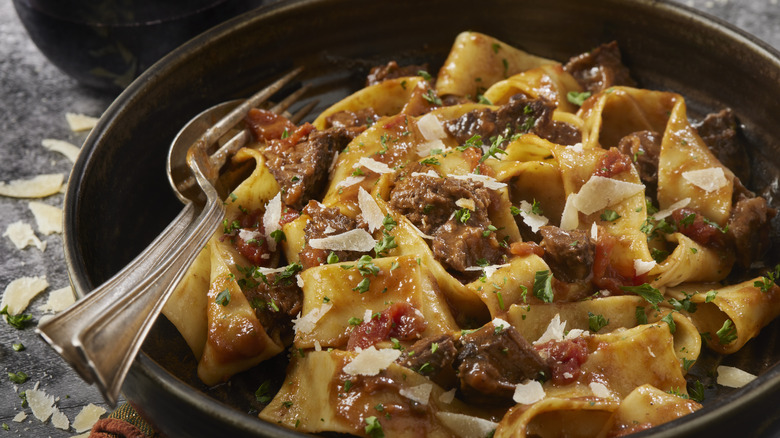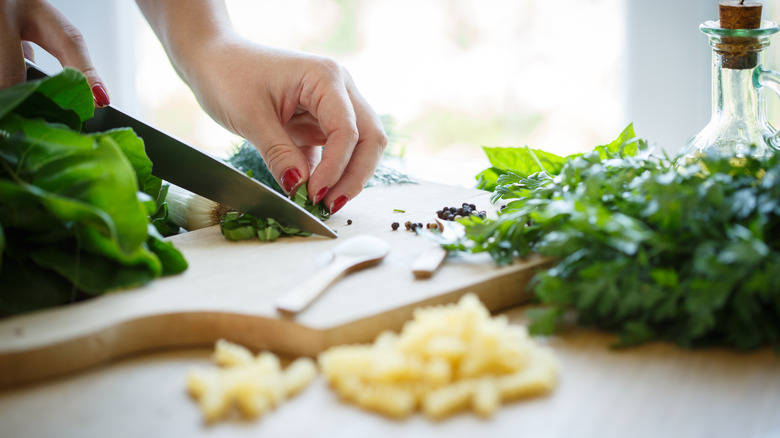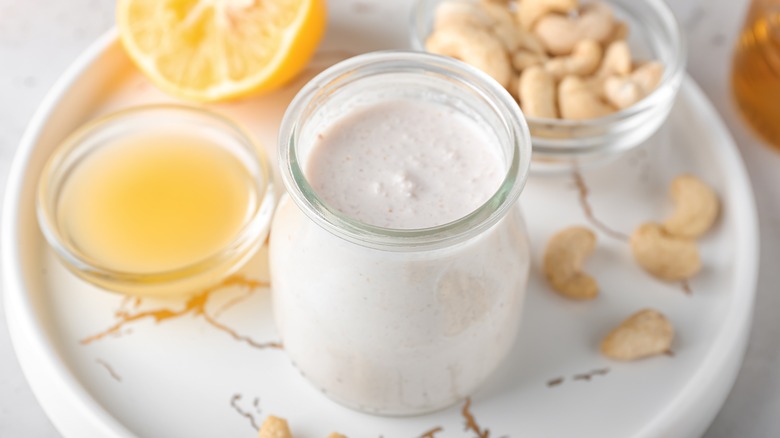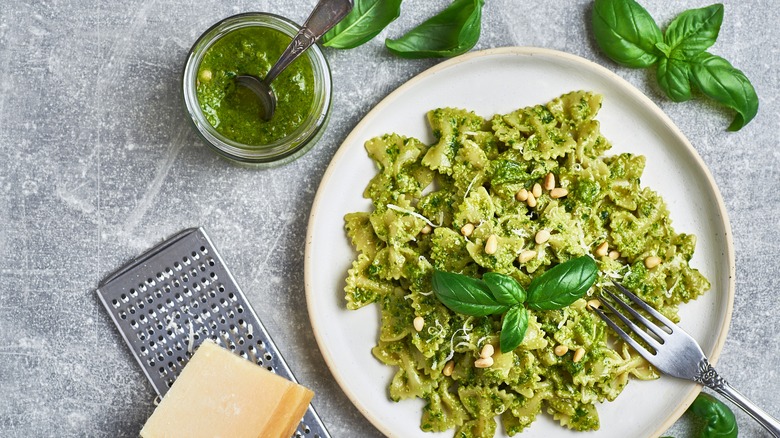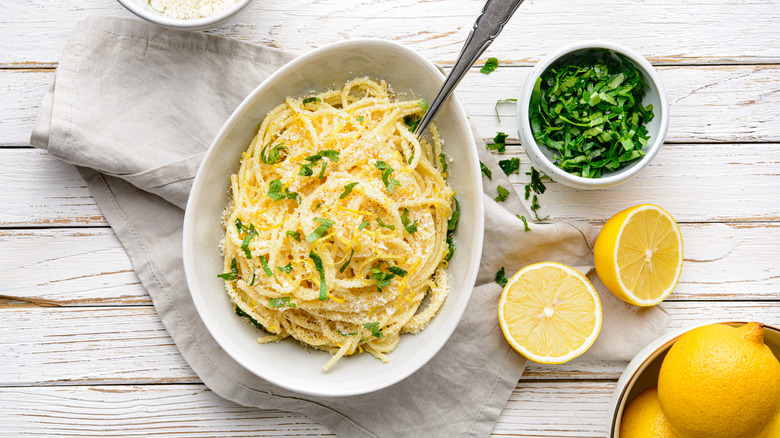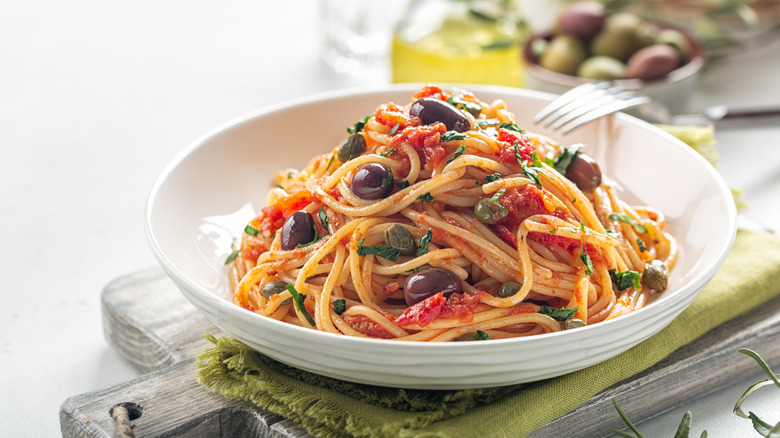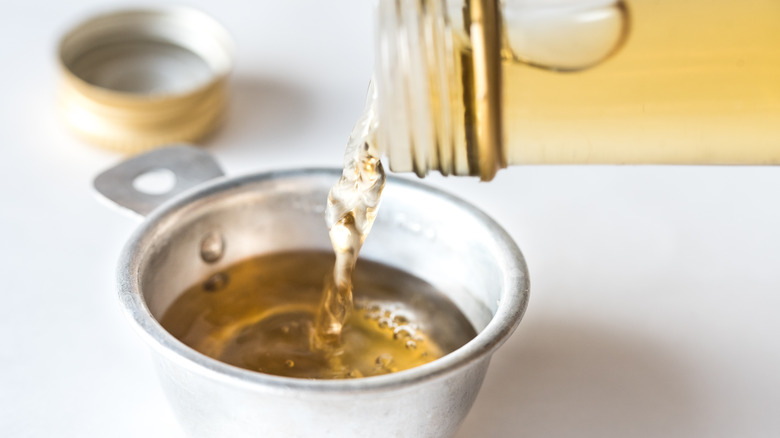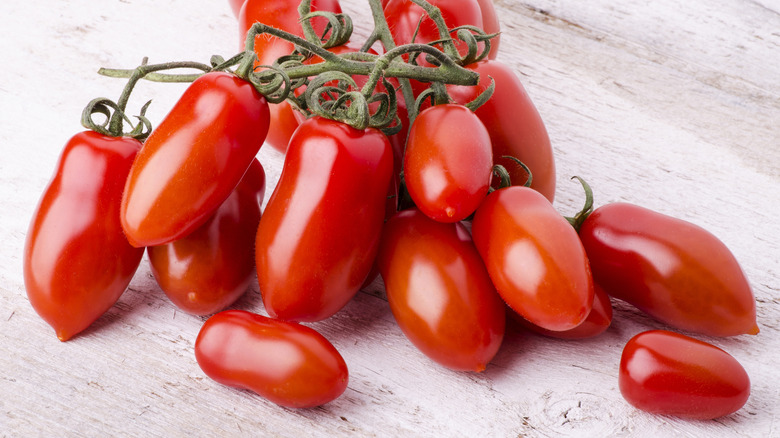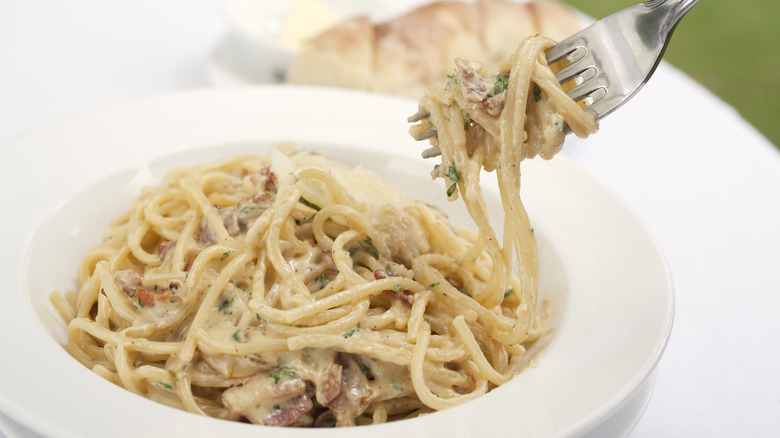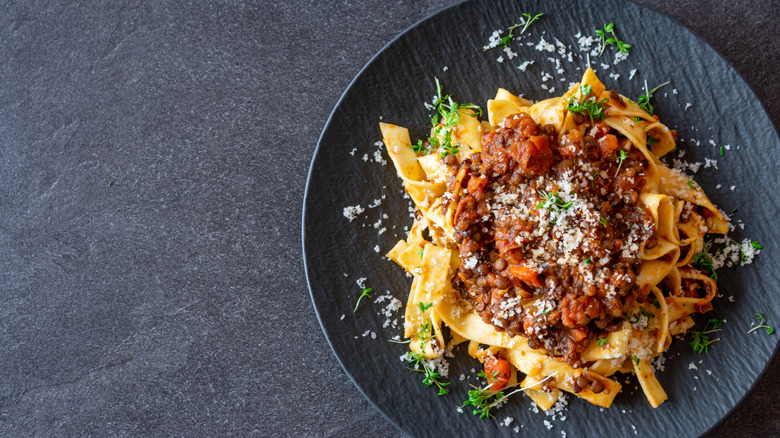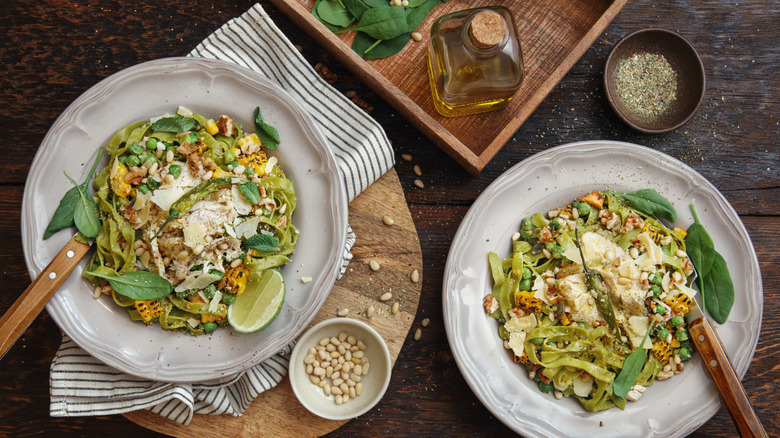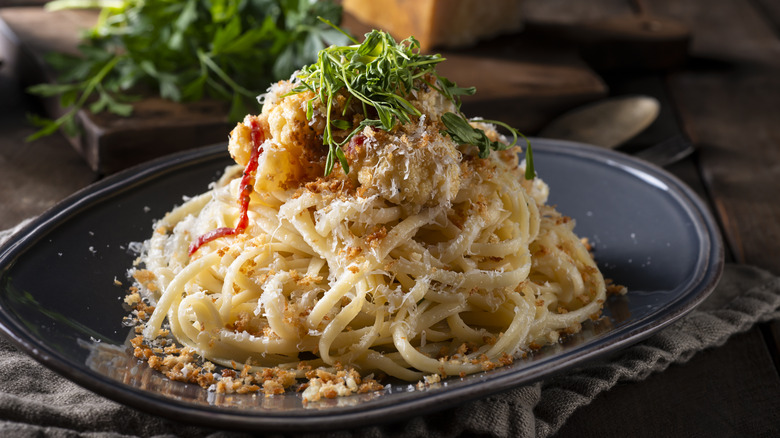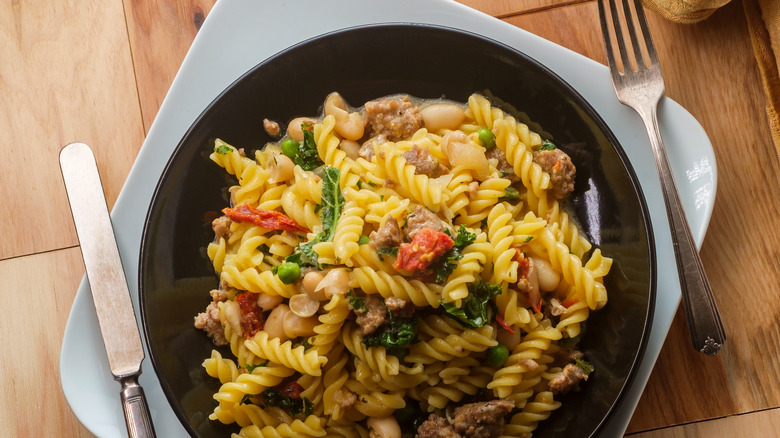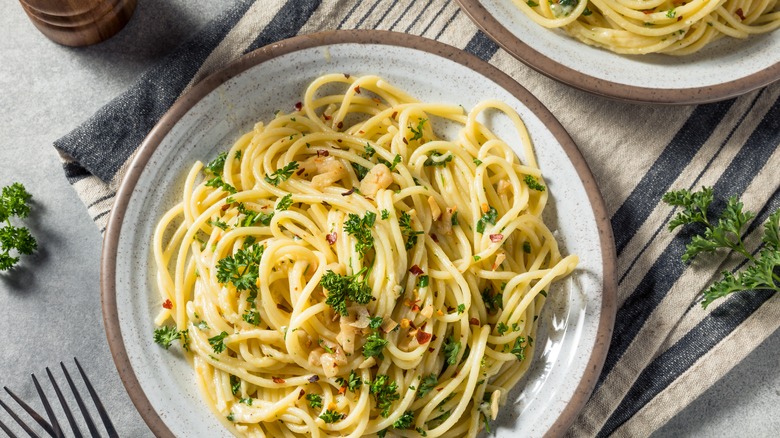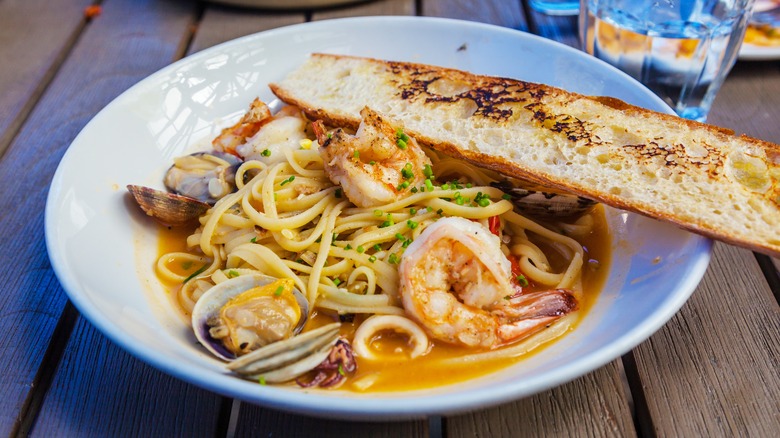14 Best Ingredients To Take Your Pasta Dishes To The Next Level
Is there any better dish on earth than pasta? First of all, it's quite the chameleon. One day it acts as the ultimate stuff-your-face comfort food, while the next it's accompanied by red wine and candlelight for a romantic-style dinner. It's a favorite amongst kiddos and adults and comes in various styles, flavors, and appearances. But the best part about pasta is that it can appeal to all palates, no matter how bland or refined. It's a universally inclusive dish that can be enjoyed by vegetarians, meat eaters, Kosher folks, and even those on a gluten-free diet with a little modification — have you ever tried chickpea pasta? And because the options are unlimited when it comes to sauces and toppings, we've narrowed down the best ingredients to take your pasta dishes to the next level.
Whether you're a cut-and-dry pasta marinara fan, or you enjoy using your culinary creativity to experiment with new and exotic ingredients, there are a few exceptional ways to elevate your pasta experience. And while it's incredibly important to get a proper, al dente base made with freshly boiled pasta, it's also key to find just the right toppings to enhance the entire pasta-eating experience.
Fresh herbs
Now, this may seem like a no-brainer to those who cook often with fresh herbs, but they can bring a dish from basic to memorable with just a light sprinkling. If you start with a base of quality store-bought or homemade pasta, then even just extra virgin olive oil or butter, along with salt and fresh herbs can be enough to make an incredibly flavorful dish.
Consider pairing butter with lightly fried sage, or a high-quality extra virgin olive oil with basil, course sea salt, and crushed black pepper. In fact, adding fresh herbs is a top tip for perfect buttered noodles and should make its way into your easy, week-night recipe reserve. Another classic you may be used to is classic basil pesto pasta with fresh basil. But the truth is, that almost any pasta dish can be altered to include a variety of fresh herbs. Even if you're using a standard tomato sauce, be sure to top it with fresh oregano, thyme, basil, or parsley to help it really sing.
Cashew cream
While cheese has dominated the pasta scene for quite some time, there is another way to reach creamy perfection without using any dairy. This may come as a relief to vegans and lactose-intolerant folks everywhere, but we believe it's a game-changing ingredient that anyone would love. Cashews help to make the perfect vegan pasta sauce. While you may be picturing cashews butter globbed onto freshly boiled noodles, think again. Raw cashews, when soaked overnight and blended in a high-speed blender are just as creamy as Alfredo sauce and don't carry any nutty or roasted flavors.
Be sure to flavor your cashew cream with lemon juice, a small amount of a sweetener of your choice, onion powder, granulated garlic, dijon mustard, salt, pepper, and quite a bit of nutritional yeast. These ingredients will help to create a familiar and balanced mouthfeel similar to a classic Alfredo. Use water or vegetable broth for blending, and add just enough liquid so that the cashews are fully covered. Add more liquid as desired, and keep in mind that the sauce will thicken when heated. As a time-saver, or for those who didn't think to start soaking their cashews the day before (who does?), soak them in hot water for about 30 minutes. If you find that the mixture is chunky at all, just keep blending until it's silky smooth.
Nuts
While it's obvious that certain meats, cheese, and vegetables were born to be paired with pasta, there is a food group that often goes overlooked. And it's an exceptionally unfortunate overlook because this food group brings something better than any other, and that's texture. You guessed it, we are talking about nuts. Now, this doesn't mean we recommend sprinkling a handful of roasted peanuts onto your pasta marinara, but there are plenty of tasteful and mouth-watering pairings that would make anyone nuts about pasta.
For instance, toasted walnuts make a meaty addition to a broth or wine-based pasta sauce. Because of their creamy and rich density, walnuts tend to pair well with lighter flavors, although they also work nicely on a tomato-based creamy vodka sauce. Picture a garlic white wine sauce with roasted kale, toasted walnuts, and pan-fried mushrooms. For a more delicate and buttery texture, try topping your pasta dish with pine nuts. The key to adding nuts to pasta is to toast them gently, and then use them as a garnish or topping, rather than mixing them right into the sauce. This will help to preserve their texture and flavor.
Lemon
Another unexpected ingredient that can take your pasta dishes to the next level comes from the fruit family. Don't worry, our prerogative isn't to convince you to add sliced banana or kiwi to your next pasta dish, but instead to include a fruit that you most likely regularly cook with and have enjoyed with pasta in the past. Lemon can make for an incredible addition to any pasta dish, from a tomato-based sauce to a broth or cream-based sauce.
Add lemon juice and zest to your white wine and garlic sauce, cashew cream, or parsley scampi recipe. Slice and roast or grill lemon slices and add to any pasta dish that includes chicken or seafood. The acidity of the lemon will help to give the dish a little extra zing of flavor and intensify anterior ingredients, and the chard slices are quite aesthetic. The acidity found in vinegar and citrus fruit often goes overlooked in recipes but can really produce a rounded mouthfeel if you can't quite put your finger on what your recipe is missing. If this all sounds appealing but you're not sure where to get started, follow a basic lemon spaghetti recipe.
Olives
As we all know, olive oil can be used as a main part of a pasta sauce or as a finishing ingredient. But either way you slice it there is no going wrong when it comes to adding EVOO. In the same vein, olives themselves can make an incredible addition and can bring a strong and salty flavor to any sauce. Kalamata olives pair well with tomato-based sauces, while green olives complement garlic and white wine sauces, and pasta salad.
Olives, like capers and other marinated vegetables, can help to flavor a sauce and add little power-packed morsels of flavor, creating variety with every bite. For less intense mouthfuls, consider mixing tapenade into your sauce, but keep in mind that it may be quite salty. In addition, olive juice can act as a flavorful and salty addition to any pasta dish and can also be used in pasta water during the cooking process to add depth.
Wine
What better combination is there in the universe than pasta and wine? In fact, who doesn't take an inaugural swing right from the bottle as they pull together their grandmother's famous marinara? And what better drink to accompany any pasta dish on a romantic date or just a weeknight dinner for one? There are several reasons we use alcohol in our cooking, but the main reason is that alcoholic beverages like wine and vodka impact the aromatics of a dish. Even a little bit chemically helps to amplify the flavors it comes in contact with. But don't worry about getting too tipsy from your bowl of pasta because most of the alcohol cooks off before the dish is done.
Splash your tomato-based sauce with red wine, or use white wine in your lighter, brothier sauces. White wine makes an incredible ingredient for any olive oil or butter-based garlic sauce and pairs nicely with fresh herbs. In fact, wine can be the main event. Instead of sauce, try using red wine for your next pasta dish.
San Marzano tomatoes
Everyone knows that a basic tomato sauce is elite when it comes to pasta dishes. There's a reason it's everyone's go-to and can be found on practically any Italian restaurant's menu. Tomatoes are tangy and sweet when cooked down. And for those who make their own pasta sauce at home, it's apparent that where you source your tomatoes will affect the outcome of the dish, even if ever-so-subtly. Though fresh tomatoes may seem like the obvious choice, there is a canned variety that is imported from Italy and that takes the cake.
Certified San Marzano tomatoes are grown in a unique climate and under strict regulations. They are thick, fleshy, and incredibly sweet. San Marzano tomatoes contain fewer seeds, which reduces the amount of moisture in the center, leaving more meaty flesh to cook with. They come canned in most grocery stores. Beware of San Marzano imposters that just don't live up to the original. Use blended San Marzano tomatoes in your favorite sauce recipe to take your pasta dish to the next level or try a traditional bucatini all'Amatriciana recipe featuring the special variety.
Pancetta
When it comes to flavoring pasta, it's best to include a variety of textures and coordinating flavors. Al dente pasta should be slightly chewy, hold its form beautifully, and stick flawlessly to the sauce. Toppings can help to highlight this texture but also add their own flair as long as it doesn't take over the dish. Pancetta is a meat that does this beautifully. Pancetta is a salt-cured pork belly, kind of like bacon, but sold in a different form as it's been rolled instead of slabbed during the curing process. You can typically find pancetta in the imported meats section and it often comes thinly diced (think thicker than bacon but cut into smaller squares or rectangles).
Fry your pancetta separately from your sauce, like you would bacon. It should become chewy on the inside and the fat should begin to crisp up. Use the pancetta to top your sauce. It's salty and pairs well with an Alfredo or cream-based sauce. Follow a simple spaghetti carbonara recipe with cheese, cream, peas, and pancetta if you're new to adding curred meat to your pasta dishes and don't know where to start.
Lentils
Lentils may be the last thing on your mind when it comes to whipping up a pasta dish for dinner, but we think they should be up for consideration. While they may not be an obvious choice because they can be rather starchy like pasta, when done right, lentils can complement the boiled dough beautifully. Especially black lentils and those that tend to keep their shape are a great option because they can be a meat-like alternative that's loaded with fiber.
In fact, black lentils can be used to beef up a bolognese sauce or even be used to top an Alfredo sauce. Consider lentils in your vegetarian lasagna or pair them with meats and cheese over linguini. Try a pasta e lenticchie (or pasta with lentils) recipe that is vegetable-heavy and loaded with fresh herbs and cream. Be sure that the lentils are not overcooked, as they can become starchy and mushy fairly easily. This also depends on the variety you choose, so avoid yellow and orange lentils that are typically cooked until they almost dissolve in the recipe (think Indian dhal).
Sweet corn
Corn is the sweet and juicy vegetable that seems to make an appearance every summer as the grills, flip flops, and beach balls come out of hiding. Corn on the cob is a feat to enjoy, although when it's cut from the cob it almost feels like cheating. However, sometimes you've got to do what you've got to do if you're going to use corn as an ingredient, like in a pasta dish; we think this is the right move.
Roasted corn, in particular, with little charred edges, tends to hold quite a few layers of flavor. The smoky exterior and sweet, juicy interior make for a complex pocket of sugars that seem to explode with every bite. While corn may not be a perfect ingredient in every pasta dish, it pairs beautifully with cream and cheese-based sauces and other toppings like pancetta, kale, and roasted mushrooms. It pairs particularly well with umami and meaty flavors and gives balance to heavy, creamy sauces. There's a reason that Instagram is drooling over Alex Guarnaschellis' corn pasta with sun-dried tomatoes!
Breadcrumbs
Yes, we expect to see breadcrumbs on casseroles and baked macaroni and cheese, but they aren't typically a staple when it comes to pasta. Perhaps it's because people don't want to load up their carbs with more carbs, but we believe the more the merrier! Bread crumbs help to add a buttery crunchy texture to pasta dishes and depending on how they are seasoned they can bring powerful layers of flavor as well.
The key to the perfect breadcrumb topping is to use plenty of butter or olive oil and salt. These crumbs should be toasted until they are golden brown and should melt in your mouth. People often use buttery crackers for this very reason. Nothing goes better with bread than cheese, so use breadcrumbs to top your cheese or cream-based pasta sauce. Don't go overboard, we don't want those crumbs absorbing all of the moisture.
Use with chicken or seafood pasta dishes or even those loaded with water-dense vegetables. Try whipping up a batch of spaghetti agloi e olio and calarian breadcrumbs, or use breadcrumbs to top one of your favorite cream-based recipes. Once your breadcrumbs are in place, don't forget to add cracked black pepper and fresh herbs to help enhance and balance the buttery goodness.
White beans
There is so much that can be done with beans and so many varieties to choose from. White beans, in particular, have a nutty and earthy mild flavor to them and therefore have quite a bit of range. They are delicate, buttery, and starchy, and can help to bulk up any pasta dish. White beans pair particularly well with a cream-based sauce along with kale and pancetta. They also are splendid with cream and lemon-based sauces, as well as broth and wine-based pasta sauces.
Remember when everyone was making that baked feta pasta dish with fresh tomatoes and endless herbs? Well, beans can take your baked feta pasta to the next level. Not only is it a subtle ingredient that's easily accessible and affordable, but it can add creaminess, especially to a recipe that includes baked cheese. But, don't stop there. White beans like navy beans and cannellini beans pair nicely with plenty of classic pasta accompanying vegetables like olives, spinach, mushrooms, and arugula. Adding white beans is a great way to bulk up a vegetarian pasta dish and add a creamy element that will stick to your ribs.
Extra virgin olive oil
It's no surprise that extra virgin olive oil has made its way onto our list of the best ingredients to take your pasta dishes to the next level. Olive oil was meant to be coupled with fresh pasta, and high-quality extra virgin olive oil can even act as a sauce itself with just the simple addition of sea salt and used over fresh, homemade pasta.
Olive oil can be paired with garlic, pepper flakes, and parmesan cheese as well, like in a simple aglio e olio. But, it can also be a great sidekick, used to enhance any pasta sauce you choose. Use it during the sauce-making process or use a high-quality finishing olive oil as a beautiful and flavorful garnish. This will add a slightly floral, herby, and fruity flavor, along with a dense and complete mouthfeel. Be sure to buy it as fresh as you can in order to taste these intense notes, as they tend to fade over time. No pasta dish is complete without a light drizzle of extra virgin olive oil to complement any sauce and intensify the depth and density.
Vegetable broth
Broth is yet another ingredient that may not come to mind when thinking about pasta but can elevate the flavor of a sauce intensely. Consider using vegetable broth when making a homemade tomato sauce. The key to a sweet tomato sauce is to cook it for a long period of time to allow the acidity to cook off. Once the sauce reduces and becomes thick, add vegetable broth and cook it down again. Do this until you've reached your desired level of sweetness from the tomatoes.
Vegetable broth can also be used as its own sauce base, especially when you're hoping to make a thinner or lighter sauce. This works particularly well when making a tomato-based sauce for seafood when the intention isn't to overpower the sweet and subtle flavors of the fish with the powerful intensity of tomatoes. Simply thin it out with broth, or slowly add tomato sauce to the broth until you've reached your desired ratio. For an even lighter sauce, use broth, white wine, garlic, and freshly chopped parsley, along with mixed mushrooms to make a scampi. Enjoy your broth-based pasta dish with a glass of white wine, or lighter red if you've used a gamey meat or umami-rich tomatoes.
